2005 MERCEDES-BENZ SPRINTER light
[x] Cancel search: lightPage 687 of 1232
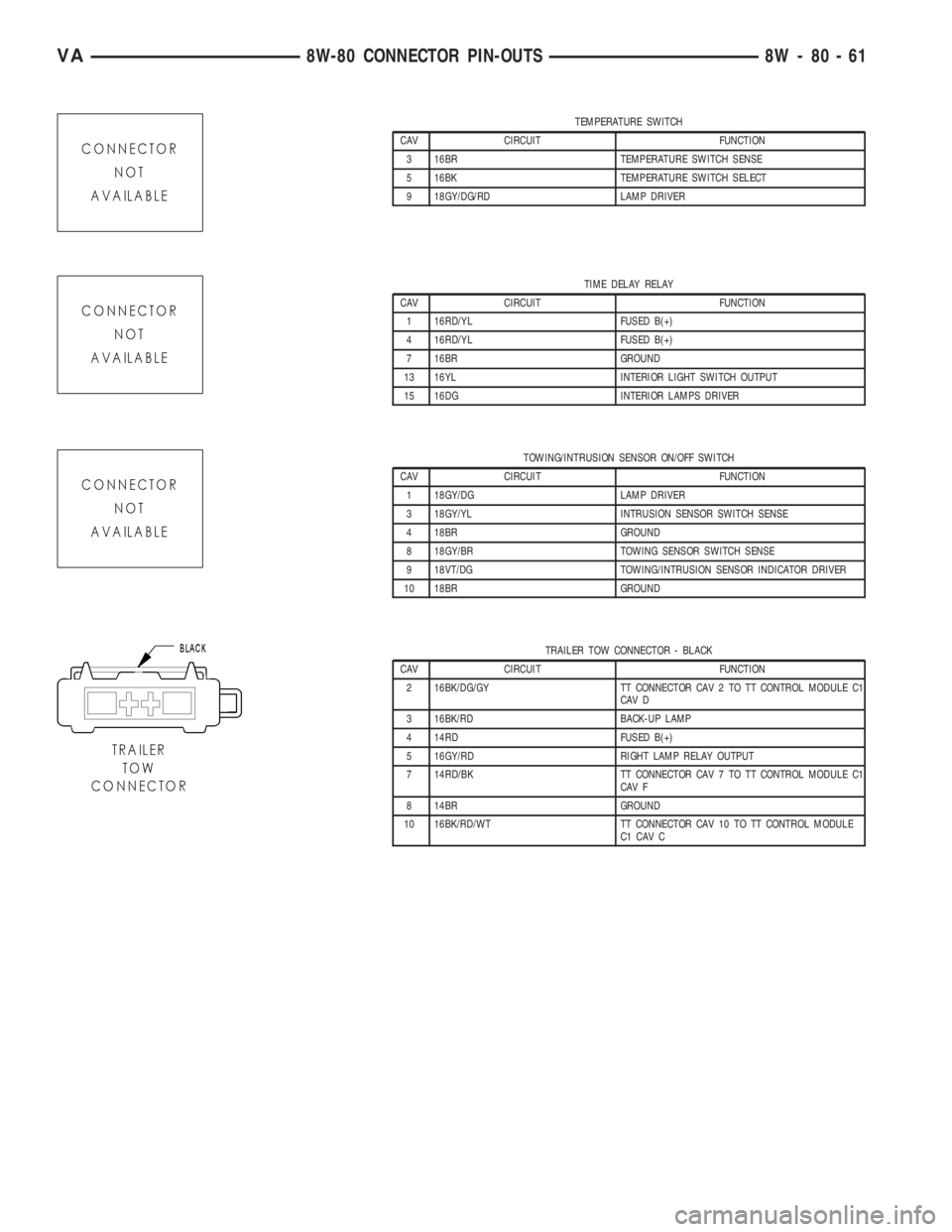
TEMPERATURE SWITCH
CAV CIRCUIT FUNCTION
3 16BR TEMPERATURE SWITCH SENSE
5 16BK TEMPERATURE SWITCH SELECT
9 18GY/DG/RD LAMP DRIVER
TIME DELAY RELAY
CAV CIRCUIT FUNCTION
1 16RD/YL FUSED B(+)
4 16RD/YL FUSED B(+)
7 16BR GROUND
13 16YL INTERIOR LIGHT SWITCH OUTPUT
15 16DG INTERIOR LAMPS DRIVER
TOWING/INTRUSION SENSOR ON/OFF SWITCH
CAV CIRCUIT FUNCTION
1 18GY/DG LAMP DRIVER
3 18GY/YL INTRUSION SENSOR SWITCH SENSE
4 18BR GROUND
8 18GY/BR TOWING SENSOR SWITCH SENSE
9 18VT/DG TOWING/INTRUSION SENSOR INDICATOR DRIVER
10 18BR GROUND
TRAILER TOW CONNECTOR - BLACK
CAV CIRCUIT FUNCTION
2 16BK/DG/GY TT CONNECTOR CAV 2 TO TT CONTROL MODULE C1
CAV D
3 16BK/RD BACK-UP LAMP
4 14RD FUSED B(+)
5 16GY/RD RIGHT LAMP RELAY OUTPUT
7 14RD/BK TT CONNECTOR CAV 7 TO TT CONTROL MODULE C1
CAV F
8 14BR GROUND
10 16BK/RD/WT TT CONNECTOR CAV 10 TO TT CONTROL MODULE
C1 CAV C
VA8W-80 CONNECTOR PIN-OUTS 8W - 80 - 61
Page 696 of 1232

CONNECTOR NAME/
NUMBERCOLOR LOCATION FIG.
Blower Motor Resistor Block
C1Instrument Panel 15
Blower Motor Resistor Block
C2Instrument Panel 15
Blower Motor Resistor Block
C3Instrument Panel 15
Blower Motor-Front Underhood Right (To The
Instrument Panel)4
Body Plug Connector Under Driver Seat N/S
Boost Pressure Sensor Engine Compartment-Left 5
Brake Fluid Level Switch Engine Compartment 3
Brake Lamp Switch C1 Pedals Area (Brake) 14
Brake Lamp Switch C2 Pedals Area (Brake) 14
Brake Wear Sensor-Left
FrontOn Left Front Wheel N/S
Brake Wear Sensor-Left Rear On Left Rear Wheel N/S
Brake Wear Sensor-Right
FrontOn Right Front Wheel N/S
Brake Wear Sensor-Right
RearOn Right Rear Wheel N/S
C100 Under Driver Seat 18
C101 Under Instrument Panel-Left 14
C200 Under Instrument Panel-Left 11
C201 Under Instrument Panel-Left 11
C202 Under Instrument Panel-Left 11
C203 Instrument Panel N/S
C204 Upper Instrument Panel-Left 11
C205 Under Driver Seat N/S
C206 Instrument Panel N/S
C207 Near Interior Light Switch-Driver N/S
C208 Near A/C Fan Switch N/S
C209 Instrument Panel N/S
C210 Instrument Panel N/S
C211 Instrument Panel N/S
C212 Instrument Panel N/S
C213 Instrument Panel N/S
C214 Instrument Panel N/S
C215 Instrument Panel N/S
C216 Instrument Panel N/S
C217 Instrument Panel N/S
C218 Under Driver Seat 18
C219 Under Driver Seat 19
C220 Instrument Panel N/S
8W - 91 - 2 8W-91 CONNECTOR/GROUND/SPLICE LOCATIONVA
CONNECTOR/GROUND/SPLICE LOCATION (Continued)
Page 697 of 1232

CONNECTOR NAME/
NUMBERCOLOR LOCATION FIG.
Cabin Heater Assembly C1 Instrument Panel N/S
Cabin Heater Assembly C2 Instrument Panel N/S
Camshaft Position Sensor Engine Compartment 7
Center High Mounted Stop
LampRear Vehicle N/S
Central Timer Module C1 Instrument Panel N/S
Central Timer Module C2 Instrument Panel N/S
Cigar Lighter Near Ash Tray N/S
Cigar Lighter Lamp Near Cigar Lighter N/S
Circulation Pump (Cabin
Heater Module)Engine Compartment-Front 4
Circulation Pump Diode Engine Compartment N/S
Circulation Pump Relay
(Relay Block)Under Driver Seat N/S
Clockspring C1 Steering Wheel 10
Clockspring C2 Steering Wheel 10,14
Contact Plate-Left Rear
License PlateRear Of Vehicle On Left N/S
Contact Switch Door-Right
RearRight Rear Door 21
Controller Antilock Brake Engine Compartment-Left 2
Courtesy Lamp - Driver Driver Door 20
Courtesy Lamp - Left Sliding
DoorLeft B-Pillar 20
Courtesy Lamp - Passenger
DoorPassenger Door 20
Courtesy Lamp - Right Rear
DoorRight Rear Door 20
Courtesy Lamp - Right
Sliding DoorRight B-Pillar 20
Crankcase Heater Engine Compartment N/S
Crankshaft Position Sensor On Engine N/S
CTEL Connector Instrument Panel N/S
Cylinder Lock Switch-Driver Driver Door 21
D(+) Relay Under Driver Seat N/S
Data Link Connector Under Dash N/S
Daytime Running Lamp
Relay (Relay Block)Under Driver Seat N/S
Daytime Running Lamp
Relay-Left Side (Relay Block)Under Driver Seat N/S
Daytime Running Lamp
Relay-Right Side (Relay
Block)Under Driver Seat N/S
Differential Lock Solenoid
ValveUnderbody 24
VA8W-91 CONNECTOR/GROUND/SPLICE LOCATION 8W - 91 - 3
CONNECTOR/GROUND/SPLICE LOCATION (Continued)
Page 700 of 1232
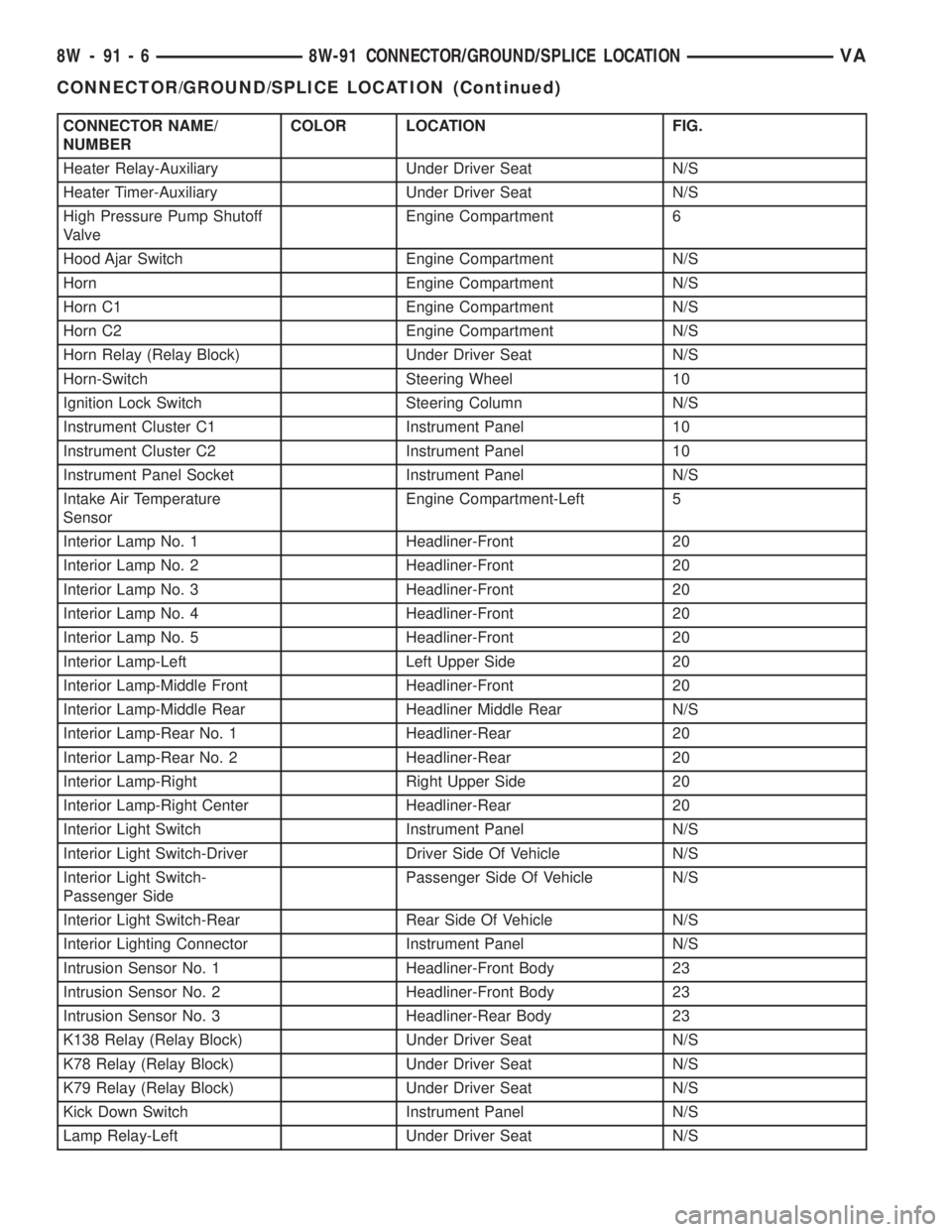
CONNECTOR NAME/
NUMBERCOLOR LOCATION FIG.
Heater Relay-Auxiliary Under Driver Seat N/S
Heater Timer-Auxiliary Under Driver Seat N/S
High Pressure Pump Shutoff
ValveEngine Compartment 6
Hood Ajar Switch Engine Compartment N/S
Horn Engine Compartment N/S
Horn C1 Engine Compartment N/S
Horn C2 Engine Compartment N/S
Horn Relay (Relay Block) Under Driver Seat N/S
Horn-Switch Steering Wheel 10
Ignition Lock Switch Steering Column N/S
Instrument Cluster C1 Instrument Panel 10
Instrument Cluster C2 Instrument Panel 10
Instrument Panel Socket Instrument Panel N/S
Intake Air Temperature
SensorEngine Compartment-Left 5
Interior Lamp No. 1 Headliner-Front 20
Interior Lamp No. 2 Headliner-Front 20
Interior Lamp No. 3 Headliner-Front 20
Interior Lamp No. 4 Headliner-Front 20
Interior Lamp No. 5 Headliner-Front 20
Interior Lamp-Left Left Upper Side 20
Interior Lamp-Middle Front Headliner-Front 20
Interior Lamp-Middle Rear Headliner Middle Rear N/S
Interior Lamp-Rear No. 1 Headliner-Rear 20
Interior Lamp-Rear No. 2 Headliner-Rear 20
Interior Lamp-Right Right Upper Side 20
Interior Lamp-Right Center Headliner-Rear 20
Interior Light Switch Instrument Panel N/S
Interior Light Switch-Driver Driver Side Of Vehicle N/S
Interior Light Switch-
Passenger SidePassenger Side Of Vehicle N/S
Interior Light Switch-Rear Rear Side Of Vehicle N/S
Interior Lighting Connector Instrument Panel N/S
Intrusion Sensor No. 1 Headliner-Front Body 23
Intrusion Sensor No. 2 Headliner-Front Body 23
Intrusion Sensor No. 3 Headliner-Rear Body 23
K138 Relay (Relay Block) Under Driver Seat N/S
K78 Relay (Relay Block) Under Driver Seat N/S
K79 Relay (Relay Block) Under Driver Seat N/S
Kick Down Switch Instrument Panel N/S
Lamp Relay-Left Under Driver Seat N/S
8W - 91 - 6 8W-91 CONNECTOR/GROUND/SPLICE LOCATIONVA
CONNECTOR/GROUND/SPLICE LOCATION (Continued)
Page 706 of 1232
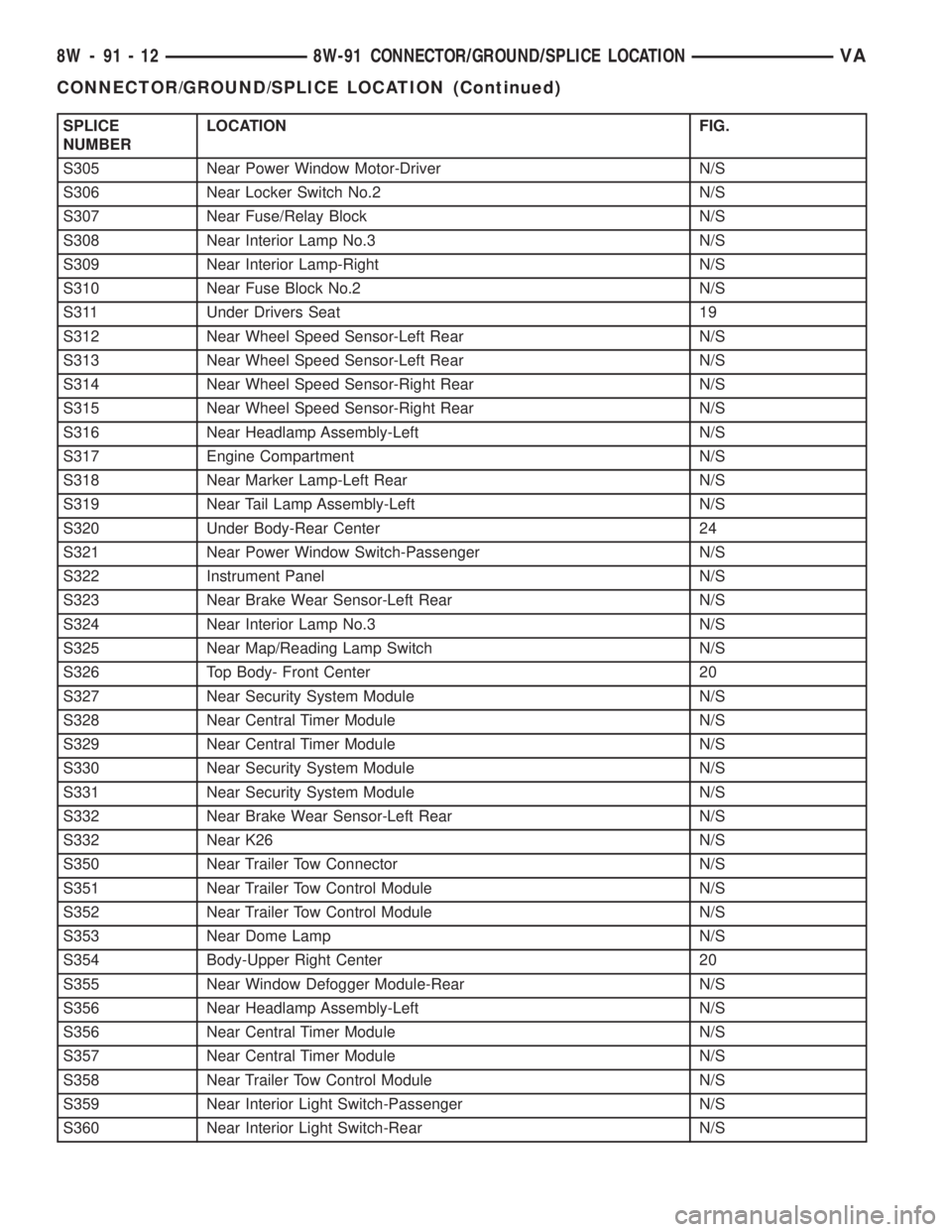
SPLICE
NUMBERLOCATION FIG.
S305 Near Power Window Motor-Driver N/S
S306 Near Locker Switch No.2 N/S
S307 Near Fuse/Relay Block N/S
S308 Near Interior Lamp No.3 N/S
S309 Near Interior Lamp-Right N/S
S310 Near Fuse Block No.2 N/S
S311 Under Drivers Seat 19
S312 Near Wheel Speed Sensor-Left Rear N/S
S313 Near Wheel Speed Sensor-Left Rear N/S
S314 Near Wheel Speed Sensor-Right Rear N/S
S315 Near Wheel Speed Sensor-Right Rear N/S
S316 Near Headlamp Assembly-Left N/S
S317 Engine Compartment N/S
S318 Near Marker Lamp-Left Rear N/S
S319 Near Tail Lamp Assembly-Left N/S
S320 Under Body-Rear Center 24
S321 Near Power Window Switch-Passenger N/S
S322 Instrument Panel N/S
S323 Near Brake Wear Sensor-Left Rear N/S
S324 Near Interior Lamp No.3 N/S
S325 Near Map/Reading Lamp Switch N/S
S326 Top Body- Front Center 20
S327 Near Security System Module N/S
S328 Near Central Timer Module N/S
S329 Near Central Timer Module N/S
S330 Near Security System Module N/S
S331 Near Security System Module N/S
S332 Near Brake Wear Sensor-Left Rear N/S
S332 Near K26 N/S
S350 Near Trailer Tow Connector N/S
S351 Near Trailer Tow Control Module N/S
S352 Near Trailer Tow Control Module N/S
S353 Near Dome Lamp N/S
S354 Body-Upper Right Center 20
S355 Near Window Defogger Module-Rear N/S
S356 Near Headlamp Assembly-Left N/S
S356 Near Central Timer Module N/S
S357 Near Central Timer Module N/S
S358 Near Trailer Tow Control Module N/S
S359 Near Interior Light Switch-Passenger N/S
S360 Near Interior Light Switch-Rear N/S
8W - 91 - 12 8W-91 CONNECTOR/GROUND/SPLICE LOCATIONVA
CONNECTOR/GROUND/SPLICE LOCATION (Continued)
Page 733 of 1232
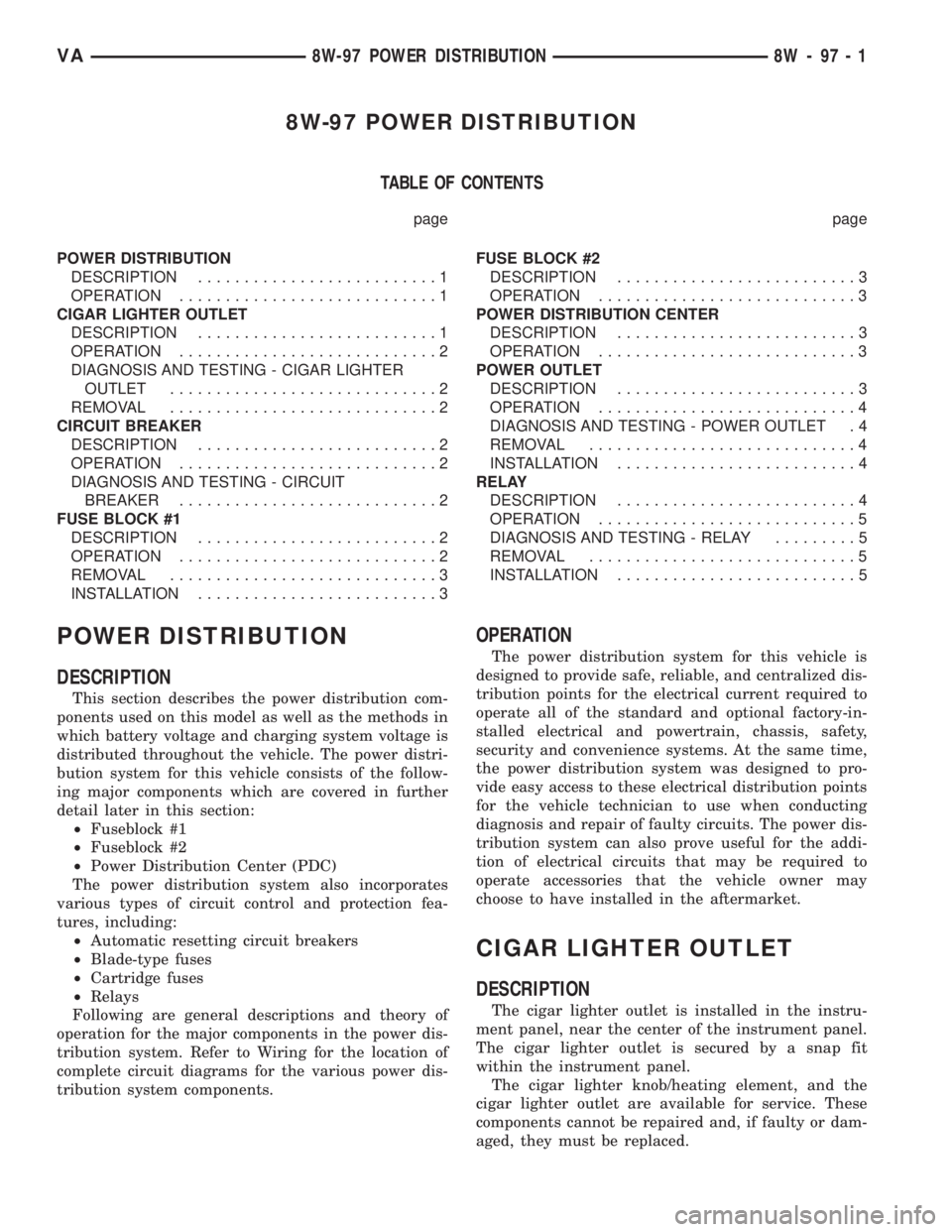
8W-97 POWER DISTRIBUTION
TABLE OF CONTENTS
page page
POWER DISTRIBUTION
DESCRIPTION..........................1
OPERATION............................1
CIGAR LIGHTER OUTLET
DESCRIPTION..........................1
OPERATION............................2
DIAGNOSIS AND TESTING - CIGAR LIGHTER
OUTLET.............................2
REMOVAL.............................2
CIRCUIT BREAKER
DESCRIPTION..........................2
OPERATION............................2
DIAGNOSIS AND TESTING - CIRCUIT
BREAKER............................2
FUSE BLOCK #1
DESCRIPTION..........................2
OPERATION............................2
REMOVAL.............................3
INSTALLATION..........................3FUSE BLOCK #2
DESCRIPTION..........................3
OPERATION............................3
POWER DISTRIBUTION CENTER
DESCRIPTION..........................3
OPERATION............................3
POWER OUTLET
DESCRIPTION..........................3
OPERATION............................4
DIAGNOSIS AND TESTING - POWER OUTLET . 4
REMOVAL.............................4
INSTALLATION..........................4
RELAY
DESCRIPTION..........................4
OPERATION............................5
DIAGNOSIS AND TESTING - RELAY.........5
REMOVAL.............................5
INSTALLATION..........................5
POWER DISTRIBUTION
DESCRIPTION
This section describes the power distribution com-
ponents used on this model as well as the methods in
which battery voltage and charging system voltage is
distributed throughout the vehicle. The power distri-
bution system for this vehicle consists of the follow-
ing major components which are covered in further
detail later in this section:
²Fuseblock #1
²Fuseblock #2
²Power Distribution Center (PDC)
The power distribution system also incorporates
various types of circuit control and protection fea-
tures, including:
²Automatic resetting circuit breakers
²Blade-type fuses
²Cartridge fuses
²Relays
Following are general descriptions and theory of
operation for the major components in the power dis-
tribution system. Refer to Wiring for the location of
complete circuit diagrams for the various power dis-
tribution system components.
OPERATION
The power distribution system for this vehicle is
designed to provide safe, reliable, and centralized dis-
tribution points for the electrical current required to
operate all of the standard and optional factory-in-
stalled electrical and powertrain, chassis, safety,
security and convenience systems. At the same time,
the power distribution system was designed to pro-
vide easy access to these electrical distribution points
for the vehicle technician to use when conducting
diagnosis and repair of faulty circuits. The power dis-
tribution system can also prove useful for the addi-
tion of electrical circuits that may be required to
operate accessories that the vehicle owner may
choose to have installed in the aftermarket.
CIGAR LIGHTER OUTLET
DESCRIPTION
The cigar lighter outlet is installed in the instru-
ment panel, near the center of the instrument panel.
The cigar lighter outlet is secured by a snap fit
within the instrument panel.
The cigar lighter knob/heating element, and the
cigar lighter outlet are available for service. These
components cannot be repaired and, if faulty or dam-
aged, they must be replaced.
VA8W-97 POWER DISTRIBUTION 8W - 97 - 1
Page 734 of 1232
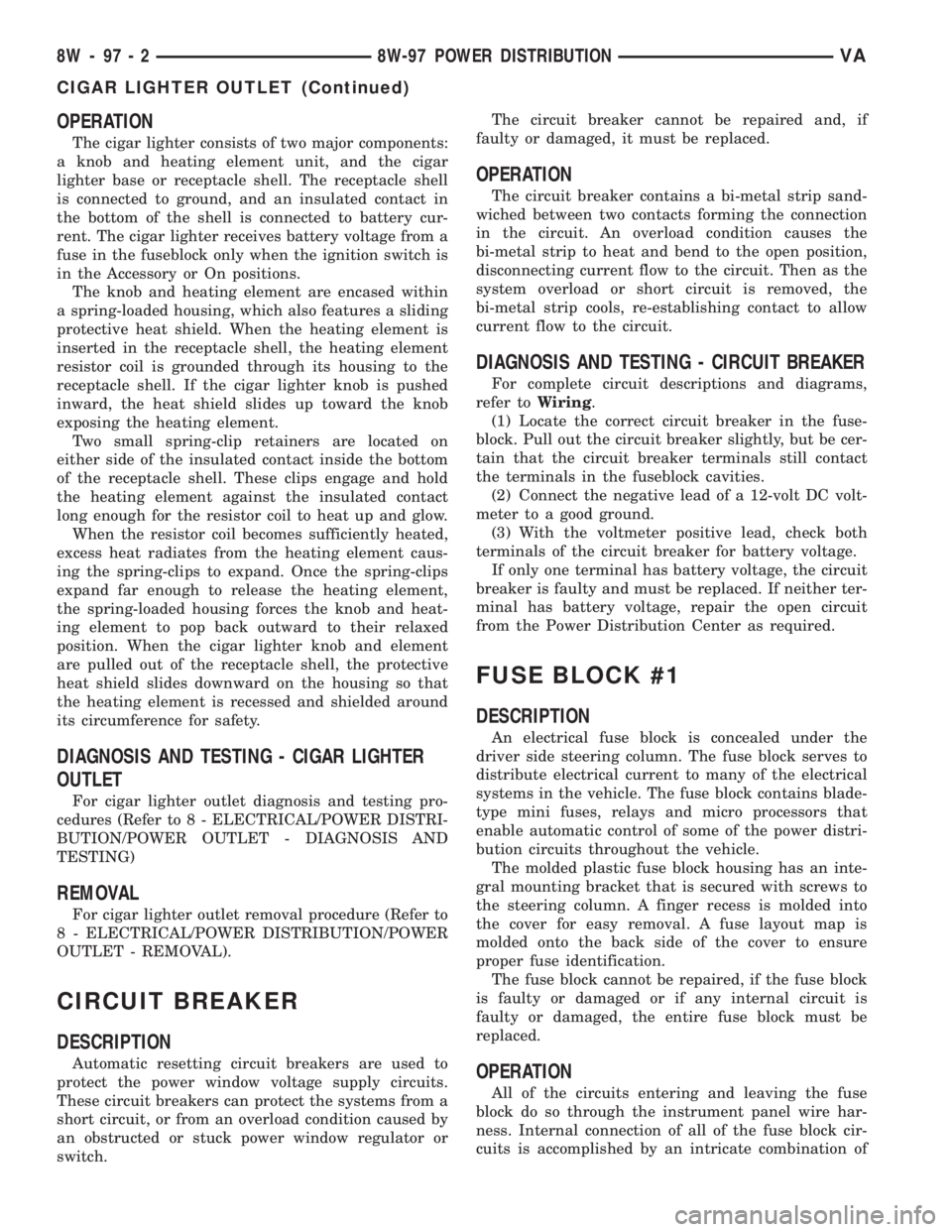
OPERATION
The cigar lighter consists of two major components:
a knob and heating element unit, and the cigar
lighter base or receptacle shell. The receptacle shell
is connected to ground, and an insulated contact in
the bottom of the shell is connected to battery cur-
rent. The cigar lighter receives battery voltage from a
fuse in the fuseblock only when the ignition switch is
in the Accessory or On positions.
The knob and heating element are encased within
a spring-loaded housing, which also features a sliding
protective heat shield. When the heating element is
inserted in the receptacle shell, the heating element
resistor coil is grounded through its housing to the
receptacle shell. If the cigar lighter knob is pushed
inward, the heat shield slides up toward the knob
exposing the heating element.
Two small spring-clip retainers are located on
either side of the insulated contact inside the bottom
of the receptacle shell. These clips engage and hold
the heating element against the insulated contact
long enough for the resistor coil to heat up and glow.
When the resistor coil becomes sufficiently heated,
excess heat radiates from the heating element caus-
ing the spring-clips to expand. Once the spring-clips
expand far enough to release the heating element,
the spring-loaded housing forces the knob and heat-
ing element to pop back outward to their relaxed
position. When the cigar lighter knob and element
are pulled out of the receptacle shell, the protective
heat shield slides downward on the housing so that
the heating element is recessed and shielded around
its circumference for safety.
DIAGNOSIS AND TESTING - CIGAR LIGHTER
OUTLET
For cigar lighter outlet diagnosis and testing pro-
cedures (Refer to 8 - ELECTRICAL/POWER DISTRI-
BUTION/POWER OUTLET - DIAGNOSIS AND
TESTING)
REMOVAL
For cigar lighter outlet removal procedure (Refer to
8 - ELECTRICAL/POWER DISTRIBUTION/POWER
OUTLET - REMOVAL).
CIRCUIT BREAKER
DESCRIPTION
Automatic resetting circuit breakers are used to
protect the power window voltage supply circuits.
These circuit breakers can protect the systems from a
short circuit, or from an overload condition caused by
an obstructed or stuck power window regulator or
switch.The circuit breaker cannot be repaired and, if
faulty or damaged, it must be replaced.
OPERATION
The circuit breaker contains a bi-metal strip sand-
wiched between two contacts forming the connection
in the circuit. An overload condition causes the
bi-metal strip to heat and bend to the open position,
disconnecting current flow to the circuit. Then as the
system overload or short circuit is removed, the
bi-metal strip cools, re-establishing contact to allow
current flow to the circuit.
DIAGNOSIS AND TESTING - CIRCUIT BREAKER
For complete circuit descriptions and diagrams,
refer toWiring.
(1) Locate the correct circuit breaker in the fuse-
block. Pull out the circuit breaker slightly, but be cer-
tain that the circuit breaker terminals still contact
the terminals in the fuseblock cavities.
(2) Connect the negative lead of a 12-volt DC volt-
meter to a good ground.
(3) With the voltmeter positive lead, check both
terminals of the circuit breaker for battery voltage.
If only one terminal has battery voltage, the circuit
breaker is faulty and must be replaced. If neither ter-
minal has battery voltage, repair the open circuit
from the Power Distribution Center as required.
FUSE BLOCK #1
DESCRIPTION
An electrical fuse block is concealed under the
driver side steering column. The fuse block serves to
distribute electrical current to many of the electrical
systems in the vehicle. The fuse block contains blade-
type mini fuses, relays and micro processors that
enable automatic control of some of the power distri-
bution circuits throughout the vehicle.
The molded plastic fuse block housing has an inte-
gral mounting bracket that is secured with screws to
the steering column. A finger recess is molded into
the cover for easy removal. A fuse layout map is
molded onto the back side of the cover to ensure
proper fuse identification.
The fuse block cannot be repaired, if the fuse block
is faulty or damaged or if any internal circuit is
faulty or damaged, the entire fuse block must be
replaced.
OPERATION
All of the circuits entering and leaving the fuse
block do so through the instrument panel wire har-
ness. Internal connection of all of the fuse block cir-
cuits is accomplished by an intricate combination of
8W - 97 - 2 8W-97 POWER DISTRIBUTIONVA
CIGAR LIGHTER OUTLET (Continued)
Page 735 of 1232
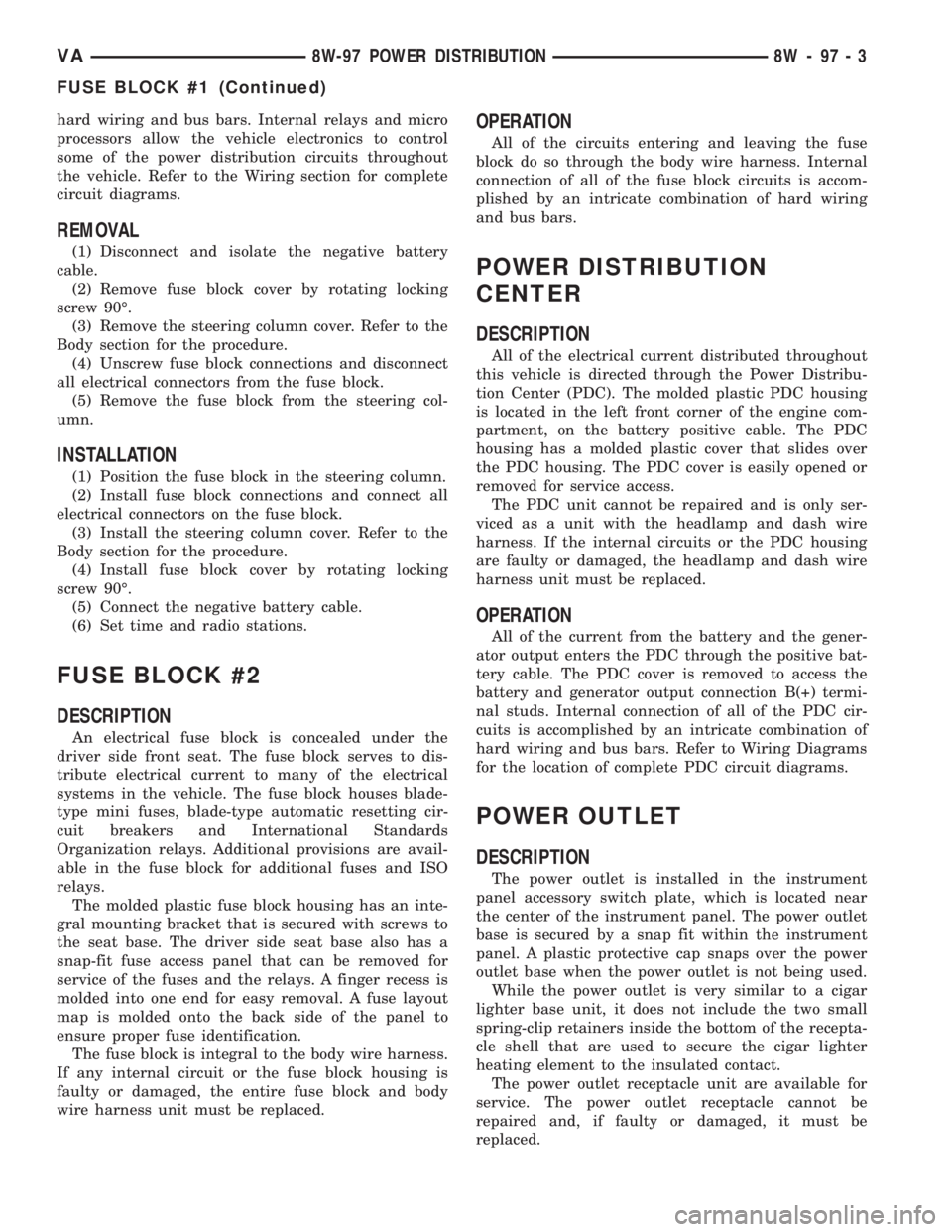
hard wiring and bus bars. Internal relays and micro
processors allow the vehicle electronics to control
some of the power distribution circuits throughout
the vehicle. Refer to the Wiring section for complete
circuit diagrams.
REMOVAL
(1) Disconnect and isolate the negative battery
cable.
(2) Remove fuse block cover by rotating locking
screw 90É.
(3) Remove the steering column cover. Refer to the
Body section for the procedure.
(4) Unscrew fuse block connections and disconnect
all electrical connectors from the fuse block.
(5) Remove the fuse block from the steering col-
umn.
INSTALLATION
(1) Position the fuse block in the steering column.
(2) Install fuse block connections and connect all
electrical connectors on the fuse block.
(3) Install the steering column cover. Refer to the
Body section for the procedure.
(4) Install fuse block cover by rotating locking
screw 90É.
(5) Connect the negative battery cable.
(6) Set time and radio stations.
FUSE BLOCK #2
DESCRIPTION
An electrical fuse block is concealed under the
driver side front seat. The fuse block serves to dis-
tribute electrical current to many of the electrical
systems in the vehicle. The fuse block houses blade-
type mini fuses, blade-type automatic resetting cir-
cuit breakers and International Standards
Organization relays. Additional provisions are avail-
able in the fuse block for additional fuses and ISO
relays.
The molded plastic fuse block housing has an inte-
gral mounting bracket that is secured with screws to
the seat base. The driver side seat base also has a
snap-fit fuse access panel that can be removed for
service of the fuses and the relays. A finger recess is
molded into one end for easy removal. A fuse layout
map is molded onto the back side of the panel to
ensure proper fuse identification.
The fuse block is integral to the body wire harness.
If any internal circuit or the fuse block housing is
faulty or damaged, the entire fuse block and body
wire harness unit must be replaced.
OPERATION
All of the circuits entering and leaving the fuse
block do so through the body wire harness. Internal
connection of all of the fuse block circuits is accom-
plished by an intricate combination of hard wiring
and bus bars.
POWER DISTRIBUTION
CENTER
DESCRIPTION
All of the electrical current distributed throughout
this vehicle is directed through the Power Distribu-
tion Center (PDC). The molded plastic PDC housing
is located in the left front corner of the engine com-
partment, on the battery positive cable. The PDC
housing has a molded plastic cover that slides over
the PDC housing. The PDC cover is easily opened or
removed for service access.
The PDC unit cannot be repaired and is only ser-
viced as a unit with the headlamp and dash wire
harness. If the internal circuits or the PDC housing
are faulty or damaged, the headlamp and dash wire
harness unit must be replaced.
OPERATION
All of the current from the battery and the gener-
ator output enters the PDC through the positive bat-
tery cable. The PDC cover is removed to access the
battery and generator output connection B(+) termi-
nal studs. Internal connection of all of the PDC cir-
cuits is accomplished by an intricate combination of
hard wiring and bus bars. Refer to Wiring Diagrams
for the location of complete PDC circuit diagrams.
POWER OUTLET
DESCRIPTION
The power outlet is installed in the instrument
panel accessory switch plate, which is located near
the center of the instrument panel. The power outlet
base is secured by a snap fit within the instrument
panel. A plastic protective cap snaps over the power
outlet base when the power outlet is not being used.
While the power outlet is very similar to a cigar
lighter base unit, it does not include the two small
spring-clip retainers inside the bottom of the recepta-
cle shell that are used to secure the cigar lighter
heating element to the insulated contact.
The power outlet receptacle unit are available for
service. The power outlet receptacle cannot be
repaired and, if faulty or damaged, it must be
replaced.
VA8W-97 POWER DISTRIBUTION 8W - 97 - 3
FUSE BLOCK #1 (Continued)